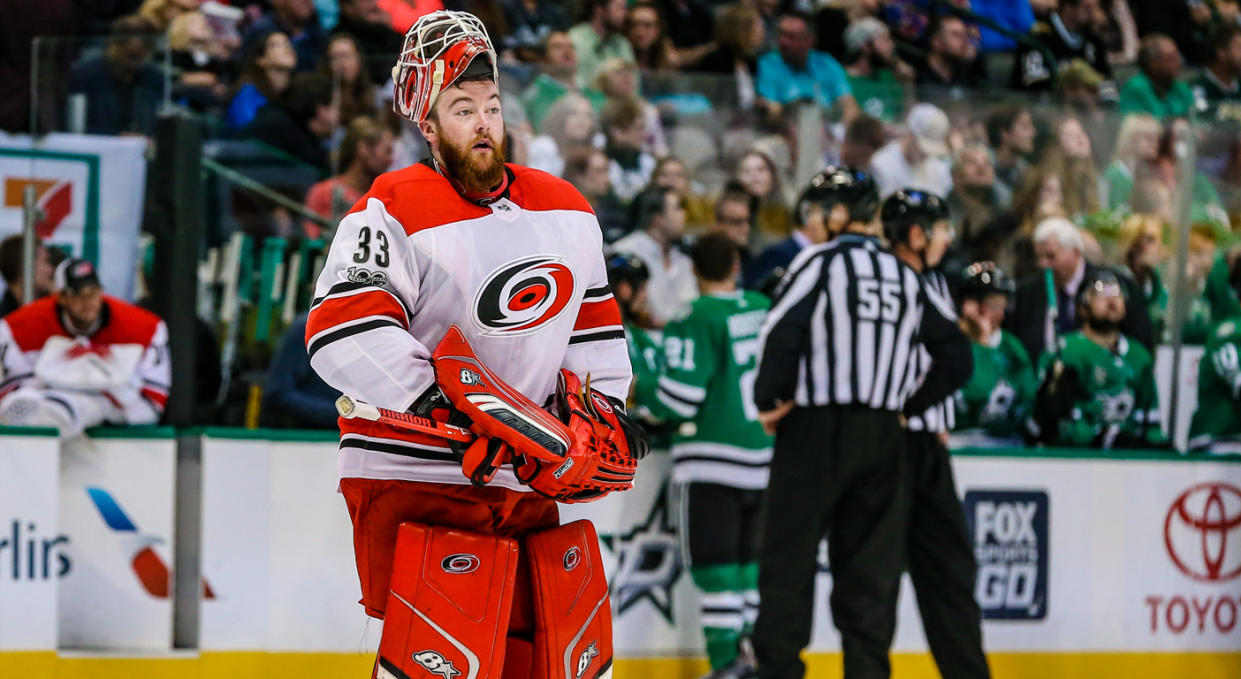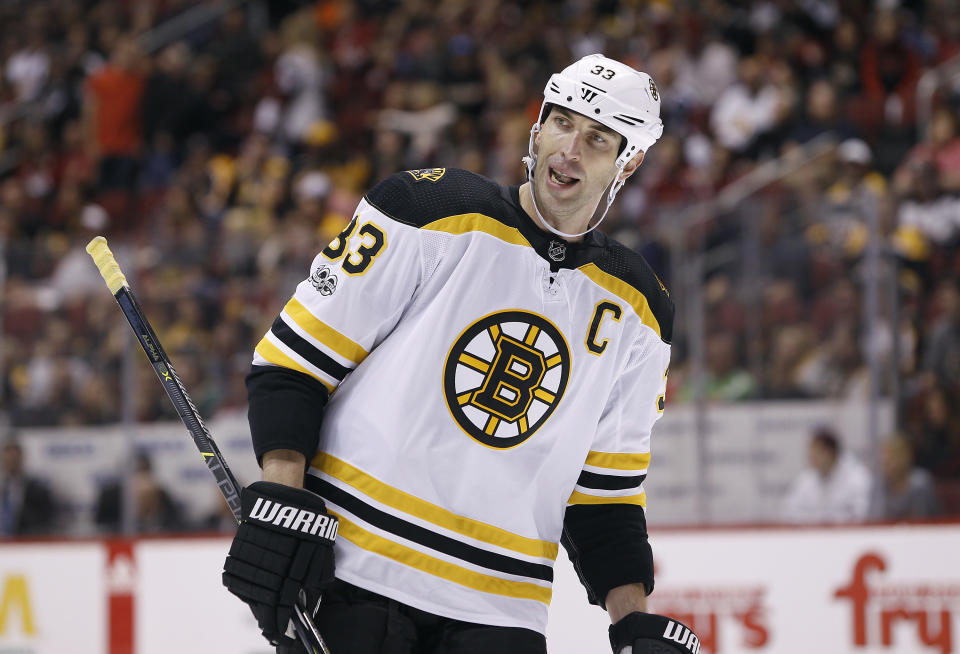Puck Daddy Bag of Mail: Carolina's start, and who can help the Leafs?

Can you believe we’re already getting to the point where teams are talking about sending guys back to their junior teams after nine-game tryouts are over, or otherwise keeping them around? How is the season already almost one-ninth done?
I mean, I understand Halloween is less than a week away, and that’s one of those things where you have to keep in mind the stuff about how hard it is to make the postseason if you’re out of a playoff spot after the start of November. So the question is, with so many surprising starts one way or the other, what do the next six months look like?
[Follow Yahoo Canada Sports on Facebook | Instagram | Twitter]
Let’s take a little walk together.
Matt asks: “Carolina was a preseason pick for a lot of people to make a jump to relevance, so what’s with their slow start?”
There have been a few problems for the Hurricanes, probably most notable of which is the fact that they’re playing dominant hockey at 5-on-5, with the second-best CF% in the league. But they’re actually getting a relatively small portion of their shots on net. That coupled with a low shooting percentage is creating problems for the offense, which only has 17 goals in seven games.
Meanwhile, the goaltending just hasn’t been there from Scott Darling, who’s a lowly .896. One wonders what goes on there, but suffice it to say part of the issue is that Carolina is allowing a lot of scoring chances, particularly of the high-danger variety, and that’s not making Darling’s job any easier. The good news is it’s a new team and it’s early, and there’s still plenty of time to turn that around. However, it’s also worth noting that he’s never been a starter and his numbers were propped up by a pretty good Chicago team that basically always gets good goaltending. Historically, the opposite has been true in Carolina, so at some point you have to wonder if it’s an institutional issue. After all, Eddie Lack had great numbers in Vancouver before his career cratered in Carolina.
The special teams haven’t really been there either. They commit very few penalties but also don’t draw a ton, and when you can’t score or defend those opportunities at league-average rates, it becomes a little tougher to compete.
All that being said, this is a team loaded with young talent and they have a really low PDO (seventh-lowest in the league, in fact) to go with a great 5-on-5 game. One imagines things will turn around.
Rashek asks via email: “Which team had ridden PDO/luck the deepest into the playoffs over the past ten seasons?”
I’m going to just sent the benchmarks here right now at a PDO north of 101 coupled with a sub-50 CF%, which highlights teams that got a lot of high percentages but generally didn’t do well at 5-on-5, which is the best predictor of long-term success. Interestingly, that still gives us about 11 percent of all the teams in the league since 2007-08 (32 out of 300).
But I’m also going to eliminate any team from the 2012-13 lockout season because, well, it was only 48 games, and seven teams out of the 32 came from that year, which tells you it was a bit of an outlier.
So that leaves us with 25 teams from 270, about 9 percent, and it won’t surprise you to learn a lot of them made the playoffs.
Here’s the breakdown:
Missed playoffs (7 teams, 28 percent)
2015-16 Senators
2014-15 Avalanche
2013-14 Maple Leafs
2013-14 Coyotes
2010-11 Stars
2008-09 Oilers
2008-09 Panthers
Out in first round (5 teams, 20 percent)
2016-17 Wild
2015-16 Panthers
2013-14 Avalanche
2011-12 Predators
2009-10 Avalanche
Out in second round (10 teams, 40 percent)
2016-17 Rangers
2016-17 Oilers
2015-16 Rangers
2014-15 Canadiens
2014-15 Flames
2013-14 Ducks
2010-11 Flyers
2010-11 Predators
2008-09 Canucks
2007-08 Canadiens
Out in conference finals (2 teams, 8 percent)
2014-15 Rangers
2011-12 Coyotes
Lost Cup Final (1 team, 4 percent)
2007-08 Penguins
Won Cup (1 team, 4 percent)
2008-09 Penguins
A couple caveats: unless you have Henrik Lundqvist or Crosby and Malkin in their primes, your ceiling is more or less “losing in the second round,” and a lot of those second-round teams lost in short order.
But the answer to your question, which I assumed would be the case going in, was the 2011-12 Coyotes, who rode Mike Smith’s one great season ever to a Western Conference Final, where the Kings humiliated them in five games. A plus-6 goal margin isn’t too impressive in five games, but that plus-71 shot margin sure is.
A.D. asks: “If you could GM for the Leafs, who would you try and target for this season?”

We know the Leafs don’t need help putting the puck in the net.
I mentioned in last week’s mailbag when talking about the Oilers, there just aren’t a lot of options out there for teams that need defense. In a recent look at their blue line situation (which so far is holding up better than I would have expected, but certainly needs some improvements), James Mirtle at the Athletic noted some reasonable targets.
The Leafs didn’t win the Travis Hamonic sweeptstakes, and might turn their attentions to someone like Mike Green (who I mentioned last week) or John Carlson (who I didn’t). One name Mirtle mentioned as a potential target, too, is Zdeno Chara, who’s a free agent after this year and also on the wrong side of 40. However, I’ve heard the Bruins would probably prefer to re-sign him if he can keep up a decently high level of play, and it would be the player’s preference as well. For the record, Chara has a no-move he would have to waive to go to Toronto, a division rival for Boston anyway.
Of course, all of this is prelude to the media ginning up years’ worth of rumors about the Leafs making a run at Drew Doughty. That’s contingent on the Kings dropping off a cliff this year.
Honestly, there just aren’t a lot of options out there unless you want to start thinking way outside the box and give up a really useful piece up front (like James van Riemsdyk) for someone who can provide long-term help. But given what it costs to wrangle a good defenseman in the offseason, let alone figuring out the machinations of in-season cap management, this might be one of those things where there’s no good answer.
Stafturd asks: “Are the numbers behind Dustin Brown’s resurgence real or is he gonna regress hard?”
I mean, all the underlying numbers are there, and that’s all you can ask for a guy. Not only that, his relative numbers are through the roof and he’s drawing a ton of penalties while taking none himself. He’s shooting the puck more, etc. etc.
He’s doing everything you could ask anyone, even leaving aside the fact that he’s someone whose contract was seen as an anchor like a month ago. But is he gonna shoot 14-plus percent forever? He is not. Is he going to have an on-ice save percentage of .953 all year? He is not.
But even if things calm down — a lot — scoring-wise, if he can keep up this level of performance, he’s going to keep putting his team in a good position.
Pekka asks via email: “What’s up with Olli Määttä? He has already eclipsed his point marks of last season and his relative possession stats are way up, though still slightly on the negative side. Is it the fact that he’s finally healthy, the Stanley Cup high, bloated shooting percentage or what?”
Unlike Brown, Maatta’s hot start is entirely percentage-driven. He’s getting buried in every situation, and the team is shooting almost 13 percent when he’s on the ice. This looks a lot like Mike Sullivan doing what he did with Justin Schultz: Putting him in a position to succeed. He’s doing it in some aspects of the game, and very much not in the ones that inform long-term success.
In short, I doubt he keeps it up all year. Being healthy doesn’t really seem to have anything to do with it.
Dylan asks via email: “Do you know enough about them to know if there are fancy stats models that exist in any level of soccer or lacrosse (both similar to hockey) that might be applicable to hockey in terms of player and/or team assessment?”
Sorta. I don’t know anything about lacrosse and would prefer to keep it that way.
I know everything — everything — in soccer gets tracked. TV broadcasts will regularly show how many miles a player has run, and I have an app on my phone that will show me not only shot locations and what happened on those shots (much like a shot chart in hockey) but also every pass made by every player all game long. You can, therefore, figure out a player’s pass completion rate, and even what happened as a result of those passes, pretty easily.
These aren’t models, of course, but it shows how far ahead soccer is in terms of simply being able to really get under the shot-metric numbers hockey has to rely on. You could, in theory, use player- and puck-tracking data to determine entire team passing success rates and evaluate how that plays into shooting and scoring and winning.
All this stuff is also available in the NBA to an absurd extent. Look at the stats page on NBA.com versus NHL.com and it’s like the data is from two different decades.
In short, greater tracking ability leads to better information about the game. There are a lot of understandable reasons the NHL can’t do it and other sports can, including changing on the fly making things very weird, the speed of the game and general difficulty in tracking the puck without putting a chip in it (which has proven difficult), and so on. Nonetheless, that’s the big impediment right now.
Mikhail asks: “Do you have any favorite single-game performances from folks who didn’t stick around in the NHL?”
I don’t know if “favorite” is the right word here, but I remember watching a game on Center Ice in 2006 (this is so weird to bring up) between Calgary and Phoenix in which a rookie named Enver Lisin was an absolute force for the Coyotes.
It was the sixth game of his career, and while he didn’t have any points — the Coyotes lost 6-1 to one of those really good Flames teams — he took six shots on goal and was generally everywhere, and got 21 minutes for some reason.
I watched that game like, “Who IS this kid?” I guess the Coyotes ended up with the same question. Two years later they traded him to the Rangers for Lauri Korpikoski and the Rangers didn’t even try to qualify him the next summer.
Lisin played only 135 NHL games, never more than 57 in a season, and had only 42 points.
He left North America for good in 2010-11, and has been a perfectly mediocre KHL player ever since. But I’m never gonna forget that damn game. It was bonkers.
Ryan Lambert is a Puck Daddy columnist. His email is here and his Twitter is here.
All stats via Corsica unless noted otherwise.


